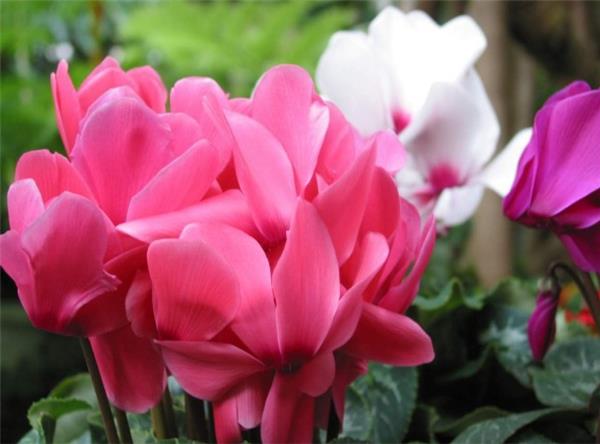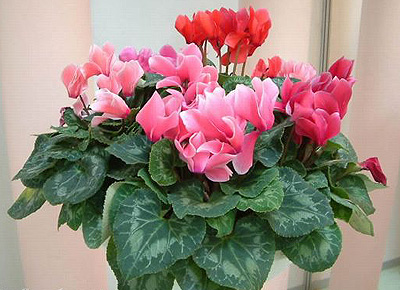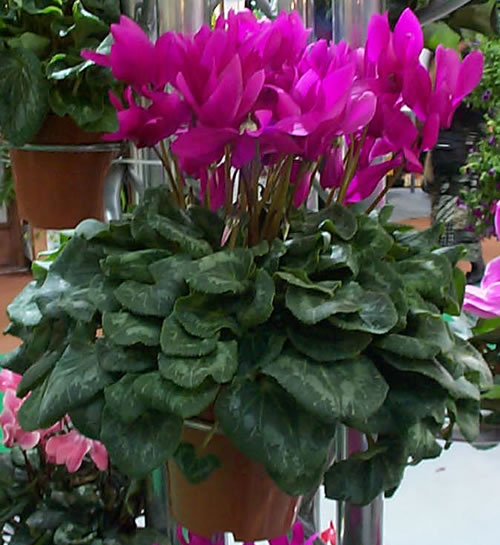How to raise cyclamen? the breeding method of cyclamen
How to raise cyclamen? Cyclamen originated in Greece, Syria, along the Mediterranean. Sex likes plenty of sunshine and warm, humid environment, avoid hot, afraid of stagnant water. So how to raise cyclamen?

Brief introduction of cyclamen
Cyclamen is a perennial bulbous flower of Primulaceae, with a flat round fleshy bulb, the old corm is purple-black-brown, covered with cork, the top of the corm is a very short stem, is the place of leaves, leaves clustered, heart-shaped oval, leaves with white reticulation, edges with teeth. Petiole and pedicel reddish brown. The flowers are large, solitary and drooping, and the petals are inversely curled like rabbit ears, so they are also known as rabbit ear flowers, with white, pink, scarlet, red, purple and so on. Flowering in winter and spring, the best viewing period is from February to April. Capsule 5-lobed, dark red.

How to raise cyclamen? the breeding method of cyclamen
1. Planting
Cyclamen can be cultivated with a mixture of 2 parts of peat and 1 part of perlite, plus a small amount of bone powder as base fertilizer. Do not change pots during dormancy. Generally dormant bulbs begin to sprout in mid-September and change pots immediately.
two。 Fertilizer application
During the growing period, rotten cake fertilizer was applied once every ten days, liquid fertilizer was applied 1-2 times before flowering, and bone powder or superphosphate was applied once more when the pedicel was ready to bloom. Stop applying nitrogen fertilizer at flowering stage to avoid falling buds. Do not apply thick fertilizer so as not to hurt the roots. Loosen the soil before applying fertilizer. It is not suitable to apply fertilizer from the top of the plant, but from the side.
3. Watering
Cyclamen to avoid too wet, watering once every morning, slowly irrigated by the edge of the basin. Do not sprinkle water directly on the leaves and the heart of the plant. Reduce the amount of water after flowering, which can be watered once every 2-3 days. At the end of July, the watering was stopped, and the leaves withered and entered the dormant period. The following spring began to water, after the growth of new leaves to increase the amount of water.
4. Temperature, light
The optimum room temperature is 18 ℃. Dormancy began when it was more than 30 ℃. When it was more than 35 ℃, the plant was easy to rot and die. Winter can withstand low temperature, it is best to maintain about 10-12 ℃, but below 5 ℃, the growth is slow, the leaves are curly, the flowers do not stretch, the flower color is dim, and the flowering is less.
There is plenty of sunshine during the growing period, but shade is still needed when the temperature is high around noon. Summer should be kept in the shade. Shade is needed in the seedling stage. From October to before flowering, enhanced light and ventilation can make the flowers last longer.

5. Pest control
(1) soft rot: it is easy to occur when it is hot and humid in summer, which harms petiole and pedicel and softens in water. If the weather is dry, the disease spot will dry up, and when it is cloudy and rainy, it will rot and stink. The pathogen overwinters in the soil.
Control methods: ① planting basin soil should be thoroughly disinfected; ② summer high temperature should control moisture, do not apply nitrogen fertilizer, do not cause plant injury, maintain air circulation, appropriate shade; ③ timely remove diseased leaves and burn them, and spray Bordeaux solution.
(2) anthrax: the disease spot is tea-brown, round and sunken, and the disease spot is enlarged after the disease spot is enlarged, giving birth to black split full seed, holding seed flying, and infecting by water.
Prevention and treatment methods: ① removed the damaged leaves and petioles and burned them; ② watered to avoid wetting leaves; 50% carbendazim 500-600 times liquid spray can be used in the initial stage of ③.
(3) nematode disease: when the soil temperature is 25-30 ℃ and the soil moisture is 40%, it is easy to cause nematode damage and invade the root to form root nodules. The growth of the injured plant was weak, the lower leaves turned yellow, and even the whole plant withered.
Control methods: ① soil disinfection, burn the damaged plants; ② soaked in 50 ℃ hot water for 10 minutes, can kill the nematode.

6. Reproduction
Cyclamen is often propagated by sowing. It is appropriate to sow seeds before and after the Beginning of Autumn in the north. Before sowing, soak the soil in boiling water for disinfection, and soak the seeds in warm water for 24 hours to promote their early germination. Sow seeds in shallow pots or wooden boxes, first load the culture soil mixed with wet sand or rotten leaf soil and garden soil, flatten the soil, pour through water, and sow according to the plant spacing of 1 square meter. Then cover about 5 mm of soil, covered with plastic film, put in a cool place in the room. Use the soaking basin method to water to keep the basin soil moist. When sowing seeds in a wooden box, you can spray water with a fine-eye spray can. At the temperature of 18-20 ℃, all the seedlings can be produced in about one month. Remove the mulch after emergence and gradually see the sun. When the seedlings grow 2-3 true leaves, they can be planted in small pots.
On how to raise cyclamen and cyclamen breeding methods Xiaobian introduced here, I hope the above content to explain to you.
Related
- Wuhan Hospital Iron Tree Blooming Result Was Instantly Frightened by the Gardener Master
- Which variety of camellia is the most fragrant and best? Which one do you like best?
- What is the small blue coat, the breeding methods and matters needing attention of the succulent plant
- Dormancy time and maintenance management of succulent plants during dormancy
- Minas succulent how to raise, Minas succulent plant pictures
- What are the varieties of winter succulent plants
- How to raise succulent plants in twelve rolls? let's take a look at some experience of breeding twelve rolls.
- Attention should be paid to water control for succulent plants during dormant period (winter and summer)
- Watering experience of twelve rolls of succulent plants
- Techniques for fertilizing succulent plants. An article will let you know how to fertilize succulent plants.



